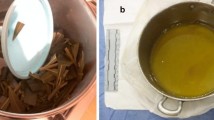Abstract
Intravenous administration of 6 mg per kg lead acetate to rabbits resulted in plumbism with elevated erythrocyte lead levels and marked depression of activity of erythrocyte δ-aminolevulmic acid dehydratase. By comparison other erythrocyte enzymes were insensitive to the effects of lead. Activities of anaerobic glycolysis and of the hexose monophosphate shunt were unaffected by lead administration as were erythrocyte methemoglobin reductase, acid phosphatase, glucose-6-phosphate dehydrogenase, malic dehydrogenase and acetylcholinesterase. The insensitivity of these erythrocyte enzymes to inhibition by lead excludes their usefulness for detection or diagnosis of plumbism.
Zusammenfassung
Kaninchen erhielten eine einmalige intravenöse Injektion von Bleiacetat (6 mg/kg KG) und entwickelten eine typische Bleivergiftung mit erhöhtem Erythrocyten-Bleigehalt und starker Erniedrigung der Erythrocyten δ-Aminolävulmsäure-Dehydratase-Aktivität. Weitere Erythrocyten-Enzyme wurden untersucht und durch Blei nicht beeinträchtigt gefunden. Insbesondere bleiben die anaerobe Glykolyse und der Hexosemonophosphat-Shunt ungestört ebenso wie die Aktivität der Erythrocyten-Methämoglobin-Reduktase, der sauren Phosphatase, der Glucose-6-phosphat-Dehydrogenase, der Maleinsäure-Dehydrogenase und der Acetylcholin-Esterase. Die Erwartung, daß diese Erythrocyten-Enzyme von Nutzen sein können bei der Feststellung oder Diagnose der Bleivergiftung, hat sich nicht erfüllt.
Similar content being viewed by others
References
Berman, E.: The biochemistry of lead: Review of the body distribution and methods of lead determination. Clin. Pediat. (Phil.) 5, 287–291 (1966).
Bonsignore, D.: L'attività ALA-deidratasica eritrocitaria quale test diagnostico nel saturnismo professionale. Med. Lavoro 57, 647–654 (1966).
Bradley, J. E., Powell, A. E., Niermann, W., McGrady, K. R., Kaplan, E.: The incidence of abnormal blood levels of lead in a metropolitan pediatric clinic with observation of coproporphyrinuria as a screening test. J. Pediat. 49, 1–6 (1956).
Buckley, E. S., Powell, B. S., Gibson, J. G.: The separation of the formed elements of whole blood by means of Fraction 1. J. Lab. clin. Med. 36, 29–39 (1950).
Byers, R. K.: Lead poisoning. Review of literature and report on 45 cases. Pediatrics 23, 585–603 (1959).
—, Lord, E. E.: Late effects of lead poisoning on mental development. Amer. J. Dis. Child. 66, 471–494 (1943).
Cartwright, G. E.: Diagnostic laboratory hematology, 4. ed. New York: Grüne & Stratton 1968.
Chapman, R. G., Hennessey, M. A., Waltersdorph, A. M., Huennekens, F. M., Gabrio, B. W.: Erythrocyte metabolism. V. Levels of glycolytic enzymes and regulation of glycolysis. J. clin. Invest. 41, 1249–1256 (1962).
David, J. R., Abrahams, R. H. Fishbein, W. L., Fabrega, E. A.: Urinary deltaaminolevulinic acid (ALA) levels in lead poisoning. Arch, environm. Hlth 17, 164–171 (1968).
DeBruin, A.: Effect of lead exposure on the level of δ-aminolevulinic-dehydratase activity. Med. d. Lavoro 59, 6–7 (1968).
Erich, C., Waller, H. D.: Zum Verhalten von SH-Verbindungen in Erythrocyten nach in vivo-Vergiftung mit Schwermetallen und Arsen. Klin. Wschr. 45, 983–986 (1967).
Farrelly, R. O., Pybus, J.: Measurement of lead in blood and urine by atomic absorption spectrophotometry. Clin. Chem. 15, 556–574 (1969).
Gajdos, A., Gajdos-Torok, M.: Etude comparative de l'activité catalasique et du taux de la protoporphyrine libre des érythrocytes ches le Lapin intoxique, par le plomp ou par la phénylhydrazine. C. R. Soc. Biol. (Paris) 151, 457–460 (1957).
Granick, S., Mauzerall, D.: Porphyrin biosynthesis in erythrocytes 11. Enzymes converting δ-aminolevulinic acid to coproporphrinogen. J. biol. Chem. 232, 1119–1140 (1958).
Hasan, J., Vihko, V., Hernberg, S.: Deficient red cell membrane [Na++ K+]- ATPase in lead poisoning. Arch, environm. Hlth 14, 313–318 (1967).
Hegesh, E., Calmanovici, N., Avron, M.: New method for determining ferrihemoglobin reductase (NADH-methemoglobin reductase) in erythrocytes. J. Lab. clin. Med. 72, 339–344 (1968).
Hernberg, S., Nurminen, M., Hasan, J.: Oxygen and glucose consumption and lactate production of erythrocytes of workers exposed to inorganic lead. Int. Arch. Gewerbepath. Gewerbehyg. 23, 117–126 (1967).
Jonek, J., Kosmider, S., Grzybek, H.: Histochemical studies on alkaline phosphatase, acid phosphatase, adenosinetriphosphatase and diaphorase in striated muscles and heart muscle in experimental acute lead poisoning. Arch. Immunol. Ther. exp. (Warsz.) 11, 652–663 (1963).
Kaplan, E., Hertz, F., Hsu, K. S.: Erythrocyte aoetylcholinesterase activity in ABO hemolytic disease of the newborn. Pediatrics 33, 205–211 (1964).
Kirkman, H. N., Riley, H. D.: Congenital nonspherocytic hemolytic anemia. Amer. J. Dis. Child. 102, 95–66 (1961).
Mauzerall, D., Granick, S.: The occurrence and determination of δ-aminolevulinic acid and porphobilinogen in urine. J. biol. Chem. 219, 435–446 (1956).
Molé, R., Lamanna, P., Pesaresi, C., Rossi, A.: Gli enzimi glicolitici del globulo rosso nel saturnisme umano e sperimentale. Folia med. (Napoli) 48, 44–48 (1965).
Nakao, K., Wada, O., Yano, Y.: δ-aminolevulinic acid dehydratase activity in erythrocytes for the evaluation of lead poisoning. Clin. ehim. Acta 19, 319–325 (1968).
Ochoa, S.: In: Methods in enzymology, vol. 1. (S. P. Colowick, N. O. Kaplan eds.), p. 735. New York: Academic Press 1959.
Pfleiderer, G., Dose, K.: Eine enzymatische Bestimmung der L-(+)-Milchsäure mit Milchsäuredehydrase. Biochem. Z. 326, 436–441 (1955).
Rogers, L. E., Porter, F. S., Sidbury, J. B.: Thiamine-responsive megaloblastic anemia. J. Pediat. 74, 494–504 (1969).
Smith, H. D., Baehner, R. L., Carney, T., Majors, W. J.: The sequelae of pica with and without lead poisoning. Amer. J. Dis. Child. 105, 609–616 (1963).
Valentine, W. N., Tanaka, K. R., Fredricks, R. E.: Erythrocyte acid phosphatase in health and disease. Amer. J. clin. Path. 36, 328–332 (1961).
Wolfe, S. J., Brin, M., Davidson, C. S.: The effect of thiamine deficiency on human erythrocyte metabolism. J. clin. Invest. 37, 1476–1484 (1958).
Author information
Authors and Affiliations
Rights and permissions
About this article
Cite this article
Rogers, L.E., Battles, N.D., Reimold, E.W. et al. Erythrocyte enzymes in experimental lead poisoning. Arch. Toxikol. 28, 202–207 (1971). https://doi.org/10.1007/BF00330249
Received:
Issue Date:
DOI: https://doi.org/10.1007/BF00330249




